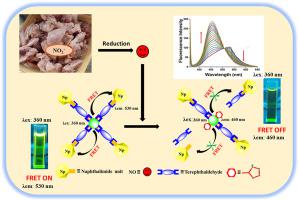Analytica Chimica Acta ( IF 5.7 ) Pub Date : 2023-05-26 , DOI: 10.1016/j.aca.2023.341444 Amanpreet Singh 1 , Gagandeep Singh 2 , Navneet Kaur 3 , Narinder Singh 1

|
Nitric oxide (NO) is a ubiquitous, gaseous, free radical signaling molecule which plays a key role in physiological and pathological processes. Literature reports revealed that the conventional methods such as colorimetry, electron paramagnetic resonance (EPR), electrochemical etc. to detect NO are costly, time consuming and lack resolution, particularly in aqueous or biological system. Thus, in this context, herein we have developed covalently linked biomass derived carbon quantum dots (CQDs) and naphthalimide based nano sensor system for FRET based ratiometric detection of nitric oxide (NO) in pure aqueous media. The CQDs derived from orange peels were characterized using UV–visible absorption, fluorescence spectroscopy, PXRD, TEM, FT-IR and zeta potential studies. Further, the obtained CQDs were functionalized with amine functionality, and subsequently linked with naphthalimide derivative (5) using terephthaldehyde through covalent bond formation. The conjugation of naphthalimide (5) and functionalized CQDs was studied using DLS, zeta potential, FT-IR and time resolved fluorescence spectroscopy. The excitation of developed nano sensor system at λex 360 nm results in fluorescence emission at λem 530 nm which establishes the FRET pair between the CQDs and naphthalimide unit. However, in the presence of NO, the observed FRET pair abolishes due to the cleavage of NO susceptible imine bond. The developed sensor demonstrates high selectivity towards NO with limit of detection (LOD) and limit of quantification (LOQ) of 15 nM and 50 nM respectively. Further, the developed sensor system was also utilized for indirect detection of nitrite (NO2−) in food samples for food safety and monitoring.
中文翻译:

从生物质衍生的荧光碳量子点和萘酰亚胺制备基于 FRET 的纳米传感器用于一氧化氮的比率检测:检测肉类样品中的亚硝酸盐水平
一氧化氮 (NO) 是一种普遍存在的气态自由基信号分子,在生理和病理过程中起着关键作用。文献报道揭示了比色法、电子顺磁共振(EPR)、电化学等常规方法。检测 NO 成本高、耗时且缺乏分辨率,尤其是在水性或生物系统中。因此,在这种情况下,我们在这里开发了共价连接的生物质衍生碳量子点 (CQD) 和基于萘酰亚胺的纳米传感器系统,用于纯水介质中基于 FRET 的一氧化氮 (NO) 比率检测。使用紫外-可见吸收、荧光光谱、PXRD、TEM、FT-IR 和 zeta 电位研究对源自橙皮的 CQD 进行了表征。此外,所获得的 CQD 被胺官能团功能化,随后使用对苯二甲醛通过共价键形成与萘酰亚胺衍生物 ( 5 ) 连接。萘酰亚胺(5) 和功能化的 CQDs 使用 DLS、zeta 电位、FT-IR 和时间分辨荧光光谱进行了研究。开发的纳米传感器系统在λ ex 360 nm处的激发导致在λ em 530 nm 处的荧光发射,这在 CQD 和萘酰亚胺单元之间建立了 FRET 对。然而,在 NO 存在的情况下,观察到的 FRET 对由于 NO 易感亚胺键的裂解而消失。开发的传感器对 NO 具有高选择性,检测限 (LOD) 和定量限 (LOQ) 分别为 15 nM 和 50 nM。此外,开发的传感器系统还用于食品样品中亚硝酸盐 (NO 2 - ) 的间接检测,用于食品安全和监测。











































 京公网安备 11010802027423号
京公网安备 11010802027423号